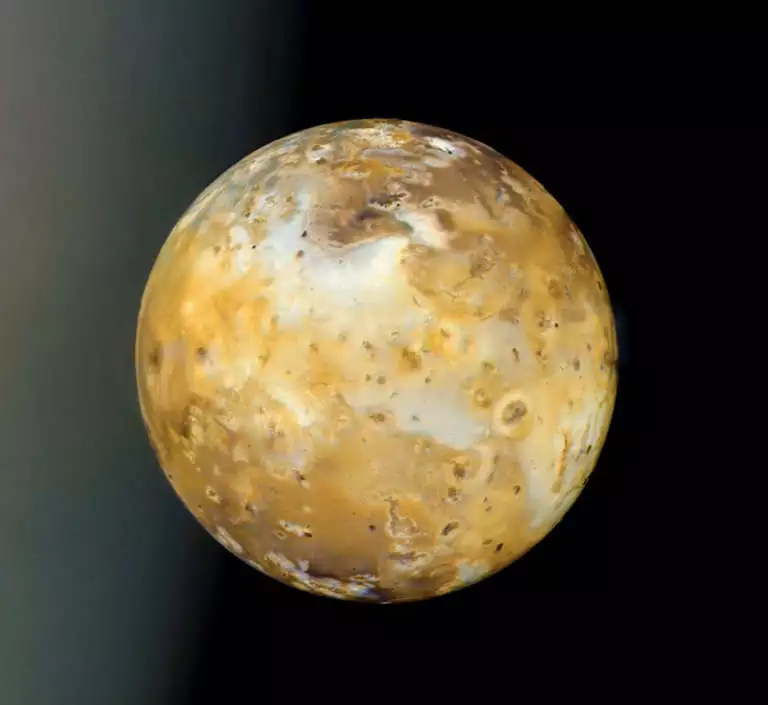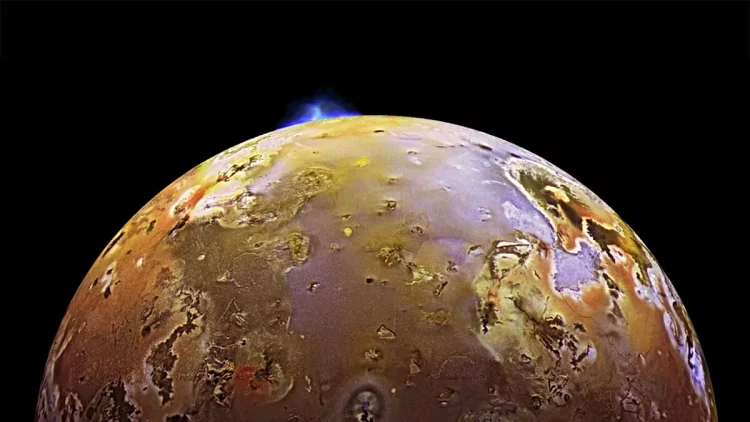Io, one of Jupiter’s four largest moons, stands out in the Solar System for its extreme volcanic activity and dynamic surface. Its tumultuous landscape, driven by intense geological processes, makes Io a key subject of study for understanding planetary geology and the interactions between moons and their host planets. This comprehensive guide explores Io’s physical attributes, geological phenomena, atmospheric conditions, exploration history, and its role in the broader context of planetary science.
I. Overview of Io
1. Basic Facts
- Size and Mass: Io is the fourth-largest moon in the Solar System, with a diameter of about 3,643 kilometers (2,263 miles). Its mass is approximately 8.93 × 10^22 kilograms, making it less massive than Earth’s Moon but still substantial in size.
- Orbit and Rotation: Io orbits Jupiter at an average distance of about 421,700 kilometers (261,000 miles). It has a synchronous rotation with its orbit, meaning it rotates on its axis once every 1.8 Earth days, the same time it takes to complete one orbit around Jupiter.
- Orbital Resonance: Io is involved in a gravitational resonance with Jupiter’s other large moons, Europa and Ganymede. This resonance creates tidal forces that contribute to Io’s intense volcanic activity. Specifically, Io’s orbit is locked in a 4:2:1 resonance with Europa and Ganymede, amplifying the tidal heating effects.
2. Appearance
- Surface Features: Io’s surface is characterized by a diverse array of features, including active volcanoes, lava plains, and sulfurous deposits. The moon’s surface displays a range of colors, from bright yellows and reds to darker browns and greens, reflecting its varied volcanic and sulfuric composition.
- Volcanic Activity: Io is the most geologically active body in the Solar System. Its surface is dotted with numerous volcanoes, some of which erupt with lava fountains that can reach heights of hundreds of kilometers. The volcanic activity is driven by tidal heating, caused by the gravitational interactions with Jupiter and the other Galilean moons.
II. Geological Features
1. Volcanism
- Active Volcanoes: Io is renowned for its high level of volcanic activity. Notable volcanoes include:
- Pillan Patera: A large volcanic caldera with an active eruption that has been observed to produce bright lava fountains and plumes.
- Loki Patera: One of Io’s largest volcanic features, Loki Patera is a vast caldera with periodic eruptions and lava lakes. It is known for its bright, colorful plumes and dynamic surface changes.
- Prometheus: An active volcano that emits sulfur dioxide and other volcanic gases, contributing to the moon’s colorful surface.
- Lava Flows: Io’s lava flows are primarily composed of silicate lava and sulfur compounds. These flows are responsible for the moon’s diverse surface colors and patterns. The lava can be extremely hot, with temperatures reaching up to 1,600 degrees Celsius (2,912 degrees Fahrenheit).
- Volcanic Plumes: Io’s volcanic plumes can reach heights of up to 500 kilometers (310 miles) above the surface. These plumes are composed of sulfur dioxide and other volcanic gases and contribute to the moon’s extended atmosphere.
2. Surface Composition
- Sulfur and Sulfide Deposits: Io’s surface is covered with sulfur and sulfur dioxide deposits. These compounds create the bright yellow and red colors seen on Io’s surface. The sulfur deposits are the result of volcanic outgassing and sublimation processes.
- Silicate Rocks: Beneath the sulfurous surface, Io is composed of silicate rocks. The volcanic activity on Io exposes these rocks and contributes to the moon’s constantly changing landscape.
- Surface Temperature: Io’s surface temperatures vary widely due to its volcanic activity. The temperatures can range from around -143 degrees Celsius (-225 degrees Fahrenheit) in the shadowed areas to more than 1,600 degrees Celsius (2,912 degrees Fahrenheit) near active lava flows.
III. Atmosphere and Magnetosphere
1. Atmosphere
- Thin Atmosphere: Io has a very thin atmosphere, composed mainly of sulfur dioxide. The atmosphere is extremely tenuous, with a surface pressure of less than 1 billionth of Earth’s atmospheric pressure.
- Volcanic Emissions: The thin atmosphere is continuously replenished by volcanic emissions from Io’s numerous volcanoes. These emissions contribute to the presence of sulfur dioxide and other gases in the moon’s atmosphere.
- Atmospheric Dynamics: Due to its thin atmosphere and constant volcanic activity, Io’s atmospheric conditions are highly variable. The presence of volcanic plumes and the interactions with Jupiter’s magnetosphere can cause changes in atmospheric composition and density.
2. Magnetosphere
- Interaction with Jupiter’s Magnetosphere: Io’s atmosphere and volcanic activity interact with Jupiter’s strong magnetic field, creating complex electromagnetic phenomena. The interaction between Io’s atmosphere and Jupiter’s magnetosphere generates intense plasma and electric currents.
- Auroras: The interaction between Io’s volcanic emissions and Jupiter’s magnetic field produces auroras in the moon’s ionosphere. These auroras are caused by charged particles trapped in the magnetic field and contribute to the moon’s dynamic environment.
IV. Exploration History
1. Early Observations
- Galileo’s Discoveries: Io was first observed by Galileo Galilei in 1610. Galileo’s observations were pivotal in understanding the moon’s volcanic activity and its dynamic surface. His discovery of Io, along with Jupiter’s other Galilean moons, revolutionized our understanding of the Solar System.
2. Space Missions
- Pioneer Missions: NASA’s Pioneer 10 and Pioneer 11 spacecraft, launched in the early 1970s, provided the first close-up images of Io. These missions revealed the moon’s volcanic features and confirmed its dynamic surface.
- Voyager Missions: The Voyager 1 and Voyager 2 spacecraft, launched in 1977, conducted detailed flybys of Jupiter and its moons in 1979. Voyager’s observations provided comprehensive data on Io’s volcanic activity and surface features, capturing images of erupting volcanoes and sulfurous deposits.
- Galileo Mission: Launched in 1989, NASA’s Galileo spacecraft entered orbit around Jupiter in 1995. Galileo’s detailed observations of Io provided extensive data on its volcanic activity, surface composition, and interaction with Jupiter’s magnetosphere. The spacecraft captured detailed images of Io’s volcanic eruptions and surface changes.
- Juno Mission: NASA’s Juno spacecraft, launched in 2011, has been studying Jupiter’s atmosphere and magnetosphere. While Juno’s primary focus is on Jupiter itself, its observations contribute to our understanding of Io’s interaction with the planet’s magnetic environment.
3. Future Missions
- Europa Clipper: Although the primary focus of the Europa Clipper mission is Europa, the spacecraft will also conduct observations of Io during its flybys of Jupiter’s moons. These observations will provide additional data on Io’s volcanic activity and surface conditions.
- JUICE Mission: The European Space Agency’s Jupiter Icy Moons Explorer (JUICE) mission, scheduled for launch in the 2020s, will study Jupiter’s moons, including Io. JUICE aims to investigate the geological activity and surface features of Io and its interaction with Jupiter’s magnetosphere.

V. Scientific Significance
1. Understanding Volcanic Processes
- Volcanic Activity: Io’s extreme volcanic activity provides insights into volcanic processes on a planetary scale. Studying Io’s volcanoes helps scientists understand the dynamics of volcanic eruptions, lava flows, and the interaction between volcanic activity and a moon’s atmosphere.
- Tidal Heating: Io’s volcanic activity is driven by tidal heating, resulting from gravitational interactions with Jupiter and the other Galilean moons. Understanding the mechanisms of tidal heating on Io provides valuable information about the forces driving volcanic activity on other moons and exoplanets.
2. Planetary Geology
- Surface Dynamics: Io’s constantly changing surface, driven by volcanic eruptions and lava flows, offers a unique opportunity to study planetary geology. The moon’s surface provides insights into the processes shaping planetary landscapes and the effects of geological activity on a moon’s environment.
- Comparison with Other Moons: Comparing Io’s volcanic and geological features with those of other moons in the Solar System, such as Europa and Enceladus, helps scientists understand the diversity of planetary processes and the factors influencing volcanic activity on different celestial bodies.
3. Astrobiological Implications
- Potential for Life: While Io’s extreme volcanic activity makes it an unlikely candidate for life, studying its environment contributes to our understanding of the conditions that can support life. The knowledge gained from Io’s geology and atmosphere helps refine our criteria for identifying potentially habitable environments on other moons and planets.


















































Discussion about this post